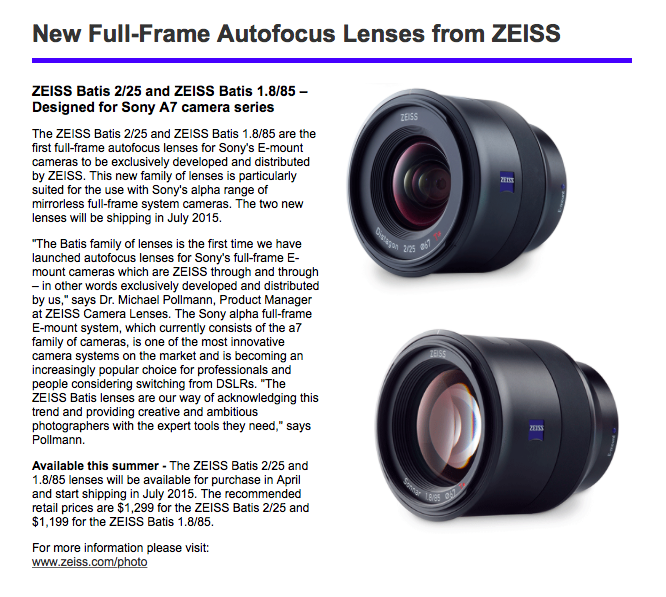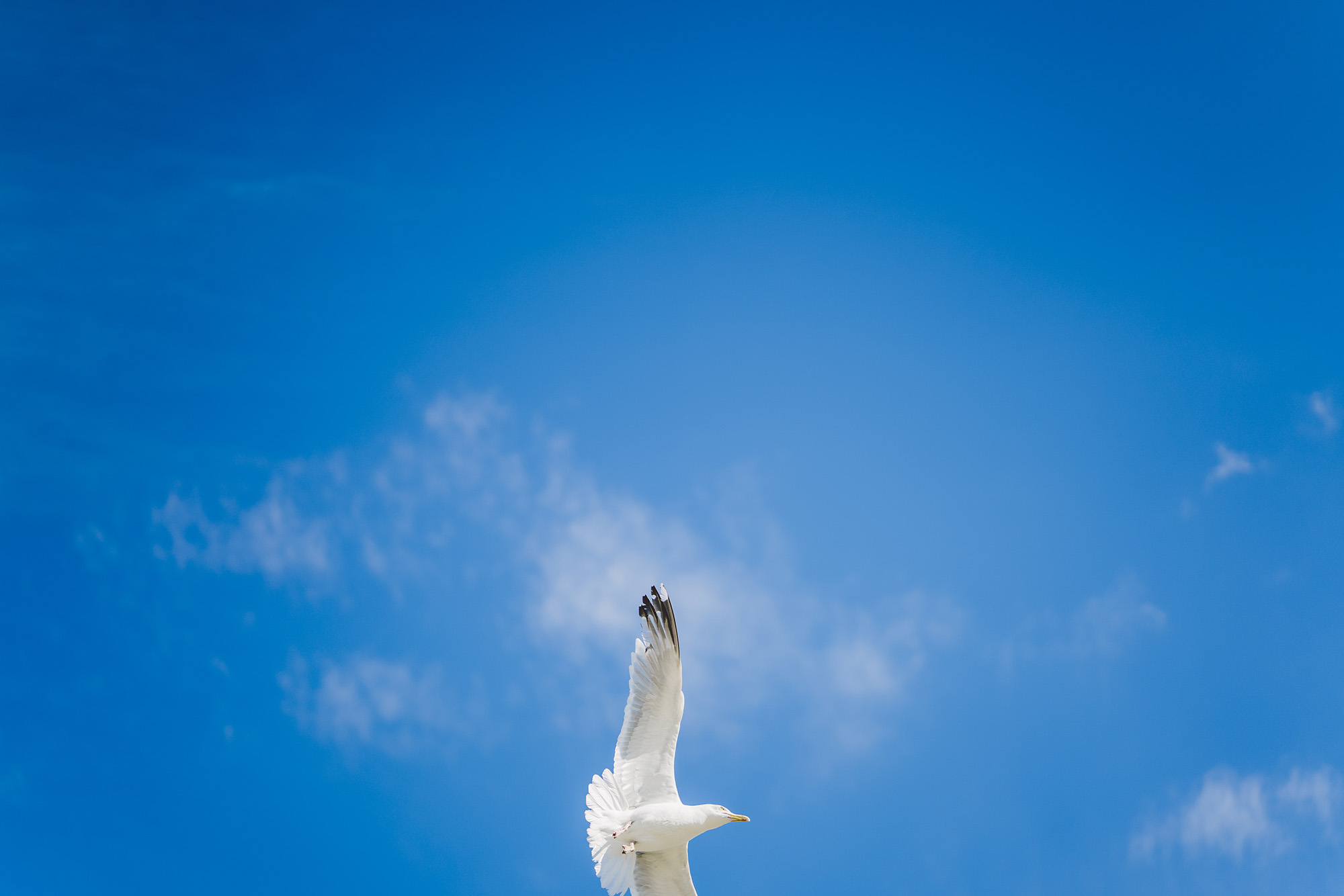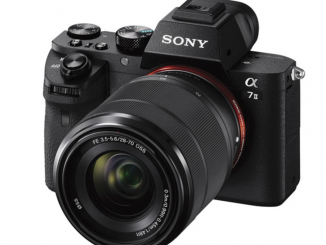New ZEISS Batis 2/25 and ZEISS Batis 1.8/85 – For Sony A7 Series
Some new lenses on the way from Zeiss! If the Loxia line wasn’t your thing due to manual focus, the new Batis lenses are coming with full AF for the Sony FE system (A7 Series). This time we have a 25m f/2 and an 85 f/1.8, two totally different focal lengths than the Loxia but both very useful IMO. The 85 should be a stunner, at least I hope so!
PRE-ORDER THE BATIS LENSES AT B&H PHOTO HERE!
PRESS RELEASE:
The ZEISS Batis 2/25 and ZEISS Batis 1.8/85 are the first full-frame autofocus lenses for Sony’s E-mount cameras to be exclusively developed and distributed by ZEISS. This new family of lenses is particularly suited for the use with Sony’s alpha range of mirrorless full-frame system cameras. The two new lenses will be shipping in July 2015.

“The Batis family of lenses is the first time we have launched autofocus lenses for Sony’s full-frame E-mount cameras which are ZEISS through and through – in other words exclusively developed and distributed by us,” says Dr. Michael Pollmann, Product Manager at ZEISS Camera Lenses. The Sony alpha full-frame E-mount system, which currently consists of the a7 family of cameras, is one of the most innovative camera systems on the market and is becoming an increasingly popular choice for professionals and people considering switching from DSLRs. “The ZEISS Batis lenses are our way of acknowledging this trend and providing creative and ambitious photographers with the expert tools they need,” says Pollmann.
Available this summer – The ZEISS Batis 2/25 and 1.8/85 lenses will be available for purchase in April and start shipping in July 2015. The recommended retail prices are $1,299 for the ZEISS Batis 2/25 and $1,199 for the ZEISS Batis 1.8/85.
For more information please visit: www.zeiss.com/photo





Anyone know delivery date??? B&H knows not… press release stated July… oops… please comment, wise ones.
This is not for me. I’m waiting for the SMALL, LIGHT and MANUAL focus (with ring aperture) LOXIAs. Would be happy to see a Loxia 25mm f2 and 90mm (or 100mm) f2 all with the same 52mm filter diameter. Maybe later a 21mm f/2.8 but not a priority. Love my Loxia 50mm!
Are the 85 F1.8 will compatible with the Sony A6000 fastest Auto Focus hybrid AF-C like the SEL24F18 SEL50F18 and other SEL lens ?
If Yes, I will sell my SAL85F14ZA and go to Batis 85 😀
I need some technical info from more knowledgeable photographers here . What effect is the ever increasing pixel density of modern sensors (eg Canon 50 Mega pixel) going to have on current or even latest edition lenses?
Will we all be forced to use Otus lenses or their equivalents to match these new super sensors ? Are we entering a new age of super lenses and super sensors ? From what I have heard an Otus is kind of a necessary lens on a Nikon D810 to get the best out of that sensor.What will happen when 50+ is reached ? Will the Loxia / Batis lenses perform well on some future 50+ mega pixel Sony A7 ?
Will latest Leica Summicrons or Luxes work on some future Leica 50+ mega pixel M camera.? For what it is worth I think file size and focusing/ camera shake issues with high res sensors should make it that these are a specialist option. In my book 20-30 Mega pixel is a sweet spot -but if pixel count becomes a marketing thing then what ?
50+ mega pixel sensors should be left to medium format IMHO -now that just might be controversial !
I wish the manufactuer’s would have a dynamic range and high ISO capability war instead of this megapixel nonsense. Above I’d prefer a shutter type and flash sync speed war too.
Mad DR, like 20+ stops of DR
Crazy high ISO with negligible noise
Flash sync speed right up there, like 1/8000’s for all the daylight strobists
Yet 24 megapixels will do fine thank you
Much more interesting.
Good question Fergus, and the true answer is not where you are looking! I believe the ultimate future in lens design will have nothing to do with pixel density, but in CURVED SENSOR technology currently under development by- guess who- Sony! I predict that curved sensors will be the next big thing in photography, and will RENDER EVERY CURRENT LENS USELESS! Curved sensors use the same principle of image projection found in nature: the eye. Consequently, lenses made to sync with this new technology will be simpler and much smaller, yet potentially capable of image quality far exceeding anything currently available. Yes, even better than a Zeiss Otus… and at a fraction of the cost!
According to Sony, their R&D of curved sensor technology is sufficiently developed to be considered, for all intents and purposes, complete. I therefore predict that a new camera/lens system will be marketed to the world probably sooner than you think, and it will be a game changer, as significant as the change from film to digital. So forget about everything you know about ANY lens… it is all about to change! That’s the world we live in, folks. Your heavy Otis will become a fancy paper weight or door-stop.
85 mm pre-ordered via this site from B&H. Now an article on how to convince the wife would be helpful Steve!
sony – balls deep
I dunno. 2015’s turning out to be an expensive year. FE 28 + FE 70-200 + FE 35/1.4 already. Throw in a Batis 85/2 and possibly an A7sII (hope so) or A9 and that’s the budget blown for the next three lifetimes.
That would be Batis 85/1.8 OS.
Yup, that would be the one! Also hadn’t realized it was optically stabilized.
The future looks expensive.
I supose that this is good glass. But I’m bit confused regarding sony/zeiss glass lineup and positioning. There are sony lenses – cheap alternative – thats clear. Zeiss lox line – quality mf glass – clear as well. There is sony / zeiss line – high end af glass, and now Batis – so where exact future lenses will go? Will there be basis and zeiss/sony line at the same time?
Yes. Sony Zeiss is premium Sony lenses, like Canon L. Zeiss lines are Zeiss’ own lenses, just like the Touits.
Wow, this is the news I’ve been waiting for. Now seriously considering moving to the A7 system. If that 2/25 is an AF of the gorgeous ZF.2 lens it should be a real stunner!
The optics are different as this lens is made for mirrorless cameras and not for DSLRs. But as it is a new construction and made by Zeiss, and not a Sony-Zeiss lens, I would expect it be very good. We’ll just have to wait for tests.
The Sony Zeiss are (mostly) pretty stunning lenses also.
Both of these should be nice lenses the mikaton 85 1.2 should offer some pretty good performance for less money than batis. Also the Sony fe 28 will offer some nice performance along with the sigma 24 art to compare to the 25 batis. I think if I was going to get either one of these it would probably be the 85 just because there is only the 85 1.2 speed master which is manual could be nice to get the 1.8 as a backup when the price drops below $1,000.
While I understand their desire to enter the AF space since that’s probably the dominant part of the market I want Loxia versions and I’m concerned Zeiss doesn’t have sufficient resources to do both in a timely way. As I’ve said on other forums I think having some kind of roadmap for Batis, Loxia, and Touit would be a big help. After all, I prefer to buy into a system that will offer consistent designs across a wide focal range like the ZM ore ZE lines. Touit has 3 lenses, Batis 2, Loxia 2, Otus 2. Seems like they are using a shotgun approach. They are not sure where they want to focus, literally IMHO. It would have been nice if they announced a followup lens in one of the other lines to know that they are doing a hit and run approach.
I was hoping for some new Loxias as well, and 85 and 25 to be exact! Not sure what the reasoning is for releasing two lines, same system, two different types (AF vs MF) and four different FL’s.
It’s the demand for AF. I’m useless at manual focusing quickly enough and I’ve been holding out for AF lenses for E-mount. Also due to modern CAD/CAM methods it must be much easier to design and manufacture new lenses these days. I guess.
Its quiet simple. Zeiss is releasing what they can to get as much market share as possible. They also working around the sensor ability. Loxia line was simple: what can we make work with A7 sensor the easiest? 35 Biogon and 50 Planar. Done.
Now, Batis is just rehoused and slightly redesigned SLR design 25mm Retrofocus lens, with AF, great choice. Plus 85mm is a bonus… The only correction I would make, I’d replace 35mm Loxia with 35/1.4 ZM distagon. (loxia bokeh is too nervous)
I think it was important for Zeiss to establish themselves in the high-end AF market for the A7, before Sigma and others got a foothold. At this point, the Batis lenses are vaporware, but their hat is in the ring, and there’s no doubt they will make good on their promise. Even if Sigma delivers something first, people will want to wait and see what Zeiss can do. The 25 and 85 are not only AF, but fill desirable gaps in the A7 lineup. This is good marketing!
Oh Zeiss, please just make something in manual focus and M mount instead – smaller sizes are way to go. Didn’t where it all start?
Wow! I guess chances are very real that Zeiss will make MF versions with the same architecture in the Loxia series. Mainly the 1.8 aperture in an 85mm would be an unexpected pleasant surprice! I’d say: GO FOR IT, ZEISS!!
It’ll be amazing if they can keep the same aperture speed + same filter size as the rest of the Loxia lineup. I can’t wait to see how they are going to do this with their wide angle offerings.
Seconded. It would be like having a whole series of ‘mini-cines’ , with exceptional image quality and sharpness across the line. I wonder how well colour matched the Loxia line would be when completed? Would make it a formidable set of primes for any a7s or FS7 video users.
From what I hear the 85mm has OS.
I think it’s great that Zeiss is putting out these lenses for the Sony E mount. I think Zeiss is a fantastic company and I own and enjoy a number of their lenses. But I won’t be rushing to buy one of these. Call me old school, but focus-by-wire is a poor cousin to true manual-focus. I like hard stops on lenses (especially useful at infinity at night or in dark situations when you can’t see well enough to focus–you can just do it by feel), as well as a depth-of-field scale, which is not a possibility with focus-by-wire lenses.
Aside from the clear advantages of a true manual-focus lens over these Zeiss Batis lenses, there is another factor to consider, which is the aesthetic value of using a helicoid-driven manual-focus lens, instead of a lens that offers an electronic simulation of the experience. Also, the durability, and therefore resale value of these lenses won’t hold up over time. Focus-by-wire lenses are manual focus in only the most rudimentary sense. It’s kind of like virtual reality–close, but not the real thing.
Mike
I absolutely agree, Mike! Let’s look forward to the Loxia versions!
I think they had an interview posted about this lens and the interviewee was talking about this lens being a video lens as well but the Zeiss spokesman corrected him and talked about how the Loxia is the lens designed for video as well. The Batis is designed for photo purposes and is similar to the Touit lineup.
The Batis has an OLED distance scale, will work perfectly well at night. The FE cameras also have an on screen distance scale, which again works at night.
I have to agree about focus-by-wire. I absolutely hate it. Not good at manual focus at the best of times, but the fake MF thing of this system really has me beat.
So many FE lenses to choose from now, I’m going Batishit crazy!
That’s clever! An OLED panel on the barrel, that shows the depth of field range. I wonder if it is selectable for meters or feet?
That OLED is Batis-hit crazy.
great!
The interesting thing about the Batis 85mm is, that it has OS. The A7II already has IBIS and the A7S & RII most likely will have too. So does it make sense to have a OS 85 Batis for such a system?! No IMHO. Zeiss is prepared for something else, where the OS makes sense. What is it?
There is 1 out of 4 A7 cameras that has ibis
…maybe offering it in Canon and Nikon mount for their future mirrorless bodies.
Dave
Sony do say that in the case of the A7ii, there is some synergy and therefore advantage to have both IBIS and lens stabilization. Hopefully Zeiss can also drive this advantage. As Hans points out, lens stabilization is also useful to existing A7 customers with bodies that do not have IBIS.
Prediction… For the future Zeiss-branded E-mount FF camera of course! It will be differentiated from the Sony’s by a RF design aesthetic and without IBIS. (One can hope, right?!)
Zeiss Ikon E, YES!
Don’t tease me. But I doubt they’d skip out on IBIS. People are going to want to use adapters and vintage lenses with an RF Ikon (ZM-like). That would be my dream camera. 24MP, great low-light, IBIS and RF design.
Yes, the A7ii has IBIS, but for translational motion only. Without OSS in the lens, tilt and yaw are only estimated. With OSS, the package is complete. I have one OSS lens, the 70-200 f4 G, and the image stabilization is rock solid.
An OSS doesn’t use any tilt or yaw movements — just translation of the optical elements. Have you ever heard of what the “Scheimpflug effect” is, and what influence a tilt of the optical axis of the lens elements would have on the focus ?
OSS corrects for attitude and yaw vibrations of the camera. IBIS only corrects for translational vibrations. I used “tilt” instead of the more correct term. It has nothing to do with the Scheimpflug effect.
Do you even realize how absurd your assertion that “IBIS only corrects for translational vibrations” is ?
Imagine you take, with a 50mm lens on a full-frame camera, the picture of a far-away mountain at a shutter speed slow enough that the picture is blurred — say, 1/8th sec.
Suppose, for the sake of argument, that the sensor has a 24MP resolution (4000×6000) and that your picture encompasses a field of view that has a width of 18 kilometers. Every pixel on the sensor would then correspond to 3 meters of the faraway mountain.
Translational blurring would require a movement of at least one pixel, which would require you to move the camera three meters laterally.
Have you seen any person who shakes so uncontrollably that they find themselves three meters away from where they started to take the picture just 1/8th seconds ago ?
The only shake that’s relevant at large-ish, non-macro distances, therefore, is the angular shake (that is, yaw, tilt, and to some extent, roll).
Hi guys, Sony A7-II’s yaw and pitch stabilization is software controlled, whereas OSS lenses have those exact two stabilizations in hardware. Therefore, whenever there is an OSS lens, camera turns off its yaw and pitch compensation and let’s the lens do its work.
In spite of all Steve’s enthusiasm, I could never get interested in the A7 series because it lacked a fast medium tele lens — by far the lens I use most. (No, the 90/2.8 macro didn’t quite cut it.) Now, all of a sudden, I’m interested.
Goodbye AZeiss 85mm f1.4 A mount, I dislike you so much. Hello native lens with hopefully managed fringing
I’ll gladly take that off your hands. No fly by wire, good ol’ fast and reliable screw drive. Zeiss quality…classic!